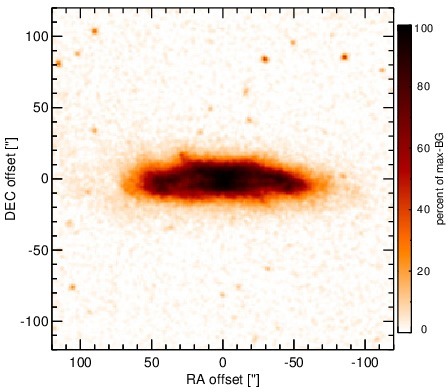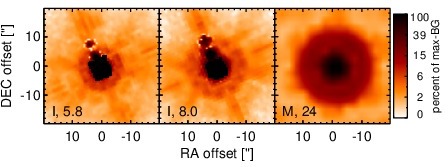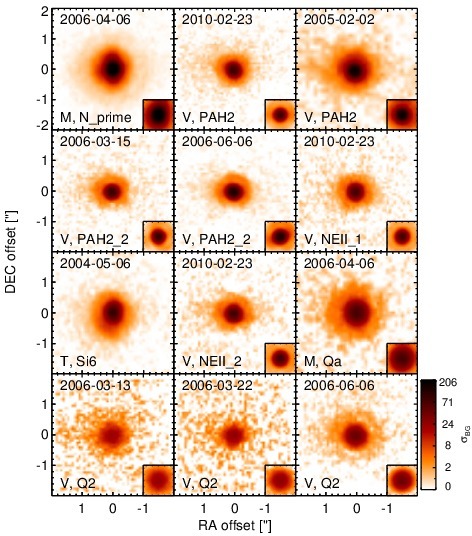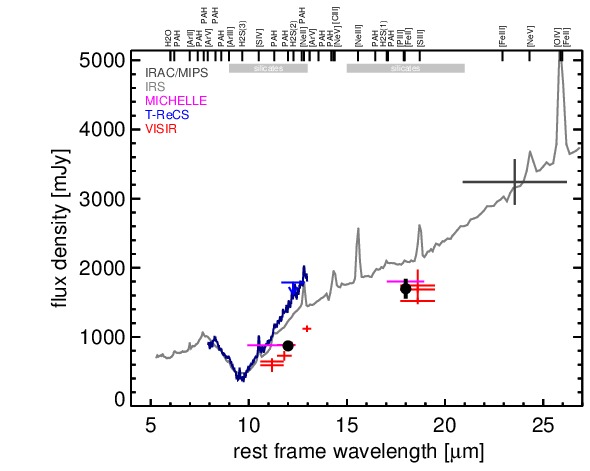Sasmirala Individual Information for NGC 5506
Description
NGC 5506 is a peculiar edge-on spiral galaxy at a redshift of z = 0.0062 (D ~ 31.6 Mpc) with an AGN classified as a Sy 1.9, a narrow-line Sy 1 or a Sy 2 nucleus (see discussion in [trippe_multi-wavelength_2010]). Broad emission lines are detected in the near-infrared [nagar_ngc_2002]. NGC 5506 is very bright in X-rays and is included in the nine-month BAT AGN sample. At radio wavelengths, it features a compact nucleus embedded within a halo elongated towards the North with ~ 3arcsec ~ 450 pc extent [wehrle_unusual_1987]. On milliarcsecond-scales, the nucleus is further resolved into a double source along a PA~ 70∘ [kinney_jet_2000]. In addition, a nuclear water maser was detected [braatz_discovery_1994]. The [O III] emission extends over several kiloparsecs and is elongated in the north-south direction [wilson_kinematics_1985]. The first ground-based MIR observations of NGC 5506 were performed by [roche_8-13_1984] in 1981 and 1982, followed by [ward_continuum_1987], [telesco_genesis_1993], and [maiolino_new_1995]. Additional low-angular resolution spectrophotometry was obtained with ISO [rigopoulou_large_1999, tran_isocam-cvf_2001]. The first subarcsecond N-band images were obtained with Palomar 5 m/MIRLIN in 2000 [gorjian_10_2004], followed by N-band spectrophotometry with ESO 3.6 m/TIMMI2 in 2001 and 2002 [siebenmorgen_isocam_2004, raban_core_2008]. An unresolved nucleus was detected in all these images, but the 11.9 μm image from [raban_core_2008] indicates extended emission towards the north-east. The Spitzer/IRAC and MIPS images are dominated by a bright compact nucleus with extended host emission visible in the IRAC images. The nucleus is saturated in the PBCD IRAC images and, thus, not analysed here (but see [gallimore_infrared_2010]). The Spitzer/IRS LR staring-mode spectrum exhibits deep silicate 10 μm and weak silicate 18 μm absorption, very weak PAH emission and a flat spectral slope in νFν-space (see also [shi_9.7_2006, wu_spitzer/irs_2009, tommasin_spitzer-irs_2010, gallimore_infrared_2010, mullaney_defining_2011]). Therefore, contribution of star formation to the arcsecond-scale MIR SED is probably minor. The SED flux levels agree with the historical data within the uncertainties, which are dominated by the steep N-band slopes caused by the silicate absorption. The nuclear region of NGC 5506 was observed with T-ReCS in N-band imaging and spectroscopic modes in 2004 [roche_silicate_2007], with Michelle in the N’ and Qa filters [ramos_almeida_infrared_2009], and with VISIR in four N and one Q band filters in 2005, 2006 and 2010 (partly published in [haas_visir_2007, reunanen_vlt_2010]). In all cases, a compact nucleus without further host emission was detected. The nucleus appears marginally resolved but is not intrinsically elongated in the sharpest images (FWHM~ 0.4arcsec ~ 60 pc). The only exception might be the Si6 image, for which no matching standard star observation could be found. Therefore, we treat the Si6 measurement as an upper limit for the unresolved nuclear emission. In neither of the images did we clearly detect the extended emission seen in the TIMMI2 11.9 μm, although some images may hint towards a slight extension in eastern direction. Our nuclear photometry is generally consistent with [ramos_almeida_infrared_2009] and [reunanen_vlt_2010], and on average ~ 26% lower than the Spitzer spectrophotometry. Note that the Michelle measurements are significantly higher than the other subarcsecond measurements because they were obtained in substandard seeing conditions. The nuclear MIR SED indicates the same silicate 10 μm absorption feature as seen in the arcsecond-scale MIR SED. Note that the T-ReCS N-band LR spectrum as published in [gonzalez-martin_dust_2013] exhibits ~ 25% higher flux levels than our photometry for unknown reasons and agrees with the IRS spectrum within the uncertainties. The difference between the arcsecond-scale and nuclear MIR SEDs is presumably caused by weak circum-nuclear star formation. The nuclear MIR emission of NGC 5506 could be further resolved with MIDI interferometric observations and was modelled as two components, one extending over \⪆10 pc, and a brighter one remaining unresolved (< 1 pc; [burtscher_diversity_2013]).
- [braatz_discovery_1994] J. A. Braatz, A. S. Wilson, and C. Henkel. The discovery of five new H2O megamasers in active galaxies . ApJL , 437 pp. L99–L102, December 1994.
- [burtscher_diversity_2013] L. Burtscher, K. Meisenheimer, K. R. W. Tristram, W. Jaffe, S. F. Hönig, R. I. Davies, M. Kishimoto, J.-U. Pott, H. Röttgering, M. Schartmann, G. Weigelt, and S. Wolf. A diversity of dusty AGN tori. data release for the VLTI/MIDI AGN large program and first results for 23 galaxies . A&A , 558 pp. 149, October 2013.
- [gallimore_infrared_2010] J. F. Gallimore, A. Yzaguirre, J. Jakoboski, M. J. Stevenosky, D. J. Axon, S. A. Baum, C. L. Buchanan, M. Elitzur, M. Elvis, C. P. O'Dea, and A. Robinson. Infrared spectral energy distributions of seyfert galaxies: Spitzer space telescope observations of the 12 μm sample of active galaxies . ApJS , 187 pp. 172–211, March 2010.
- [gonzalez-martin_dust_2013] O. González-Martín, J. M. Rodríguez-Espinosa, T. Díaz-Santos, C. Packham, A. Alonso-Herrero, P. Esquej, C. Ramos Almeida, R. Mason, and C. Telesco. Dust in active galactic nuclei. mid-infrared t-ReCS/Gemini spectra using the new RedCan pipeline . A&A , 553 pp. 35, May 2013.
- [gorjian_10_2004] V. Gorjian, M. W. Werner, T. H. Jarrett, D. M. Cole, and M. E. Ressler. 10 micron imaging of seyfert galaxies from the 12 micron sample . ApJ , 605 pp. 156–167, April 2004.
- [haas_visir_2007] M. Haas, R. Siebenmorgen, E. Pantin, H. Horst, A. Smette, H.-U. Käufl, P.-O. Lagage, and R. Chini. VISIR / VLT mid-infrared imaging of seyfert nuclei: nuclear dust emission and the seyfert-2 dichotomy . A&A , 473 pp. 369–376, October 2007.
- [kinney_jet_2000] A. L. Kinney, H. R. Schmitt, C. J. Clarke, J. E. Pringle, J. S. Ulvestad, and R. R. J. Antonucci. Jet directions in seyfert galaxies . ApJ , 537 pp. 152–177, July 2000.
- [maiolino_new_1995] R. Maiolino, M. Ruiz, G. H. Rieke, and L. D. Keller. New constraints on the unified model of seyfert galaxies . ApJ , 446 pp. 561, June 1995.
- [mullaney_defining_2011] J. R. Mullaney, D. M. Alexander, A. D. Goulding, and R. C. Hickox. Defining the intrinsic AGN infrared spectral energy distribution and measuring its contribution to the infrared output of composite galaxies . MNRAS , page 474, April 2011.
- [nagar_ngc_2002] N. M. Nagar, E. Oliva, A. Marconi, and R. Maiolino. NGC 5506 unmasked as a narrow line seyfert 1:. a direct view of the broad line region using near-IR spectroscopy . A&A , 391 pp. L21–L24, August 2002.
- [raban_core_2008] D. Raban, B. Heijligers, H. Röttgering, K. Meisenheimer, W. Jaffe, H. U. Käufl, and T. Henning. The core flux of the brightest 10 μm galaxies in the southern sky . A&A , 484 pp. 341–345, June 2008.
- [ramos_almeida_infrared_2009] C. Ramos Almeida, N. A. Levenson, J. M. Rodríguez Espinosa, A. Alonso-Herrero, A. Asensio Ramos, J. T. Radomski, C. Packham, R. S. Fisher, and C. M. Telesco. The infrared nuclear emission of seyfert galaxies on parsec scales: Testing the clumpy torus models . ApJ , 702 pp. 1127–1149, September 2009.
- [reunanen_vlt_2010] J. Reunanen, M. A. Prieto, and R. Siebenmorgen. VLT diffraction-limited imaging at 11 and 18μm of the nearest active galactic nuclei . MNRAS , 402 pp. 879–894, February 2010.
- [rigopoulou_large_1999] D. Rigopoulou, H. W. W. Spoon, R. Genzel, D. Lutz, A. F. M. Moorwood, and Q. D. Tran. A large mid-infrared spectroscopic and near-infrared imaging survey of ultraluminous infrared galaxies: Their nature and evolution . AJ , 118 pp. 2625–2645, December 1999.
- [roche_8-13_1984] P. F. Roche, B. Whitmore, D. K. Aitken, and M. M. Phillips. 8-13 micron spectrophotometry of galaxies. II - 10 seyferts and 3C 273 . MNRAS , 207 pp. 35–45, March 1984.
- [roche_silicate_2007] Patrick F. Roche, Christopher Packham, David K. Aitken, and Rachel E. Mason. Silicate absorption in heavily obscured galaxy nuclei . MNRAS , 375 pp. 99–104, February 2007.
- [shi_9.7_2006] Y. Shi, G. H. Rieke, D. C. Hines, V. Gorjian, M. W. Werner, K. Cleary, F. J. Low, P. S. Smith, and J. Bouwman. 9.7 μm silicate features in active galactic nuclei: New insights into unification models . ApJ , 653 pp. 127–136, December 2006.
- [siebenmorgen_isocam_2004] R. Siebenmorgen, W. Freudling, E. Krügel, and M. Haas. ISOCAM survey and dust models of 3CR radio galaxies and quasars . A&A , 421 pp. 129–145, July 2004.
- [telesco_genesis_1993] C. M. Telesco, L. L. Dressel, and R. D. Wolstencroft. The genesis of starbursts and infrared emission in the centers of galaxies . ApJ , 414 pp. 120–143, September 1993.
- [tommasin_spitzer-irs_2010] Silvia Tommasin, Luigi Spinoglio, Matthew A. Malkan, and Giovanni Fazio. Spitzer-IRS high-resolution spectroscopy of the 12 μm seyfert galaxies. II. results for the complete data set . ApJ , 709 pp. 1257–1283, February 2010.
- [tran_isocam-cvf_2001] Q. D. Tran, D. Lutz, R. Genzel, D. Rigopoulou, H. W. W. Spoon, E. Sturm, M. Gerin, D. C. Hines, A. F. M. Moorwood, D. B. Sanders, N. Scoville, Y. Taniguchi, and M. Ward. Isocam-cvf 5-12 micron spectroscopy of ultraluminous infrared galaxies . ApJ , 552 pp. 527–543, May 2001.
- [trippe_multi-wavelength_2010] M. L. Trippe, D. M. Crenshaw, R. P. Deo, M. Dietrich, S. B. Kraemer, S. E. Rafter, and T. J. Turner. A multi-wavelength study of the nature of type 1.8/1.9 seyfert galaxies . ApJ , 725 pp. 1749–1767, December 2010.
- [ward_continuum_1987] Martin Ward, Martin Elvis, G. Fabbiano, N. P. Carleton, S. P. Willner, and A. Lawrence. The continuum of type 1 seyfert galaxies. i - a single form modified by the effects of dust . ApJ , 315 pp. 74–91, April 1987.
- [wehrle_unusual_1987] Ann E. Wehrle and Mark Morris. An unusual radio loop in the edge-on seyfert galaxy NGC 5506 . ApJL , 313 pp. L43–L46, February 1987.
- [wilson_kinematics_1985] A. S. Wilson, J. A. Baldwin, and J. S. Ulvestad. Kinematics and ionization of extended ionized gas in active galaxies. i - the x-ray luminous galaxies NGC 2110, NGC 5506, and MCG -5-23-16 . ApJ , 291 pp. 627–654, April 1985.
- [wu_spitzer/irs_2009] Yanling Wu, Vassilis Charmandaris, Jiasheng Huang, Luigi Spinoglio, and Silvia Tommasin. Spitzer/IRS 5-35 μm low-resolution spectroscopy of the 12 μm seyfert sample . ApJ , 701 pp. 658–676, August 2009.
Images

Optical image (DSS, red filter). Displayed are the central 4 arcmin with North being up and East to the left. The colour scaling is linear with white corresponding to the median background (BG) and black to the 0.01% pixels with the highest intensity.

Spitzer MIR images. Displayed are the inner 40 arcsec with North being up and East to the left. The colour scaling is logarithmic with white corresponding to median BG and black to the 0.1% pixels with the highest intensity. The label in the bottom left states instrument and central wavelength of the filter in micron (I: IRAC, M: MIPS).

Subarcsecond-resolution MIR images sorted by increasing filter central wavelength. Displayed are the inner 4 arcsec with North being up and East to the left. The colour scaling is logarithmic with white corresponding to median BG and black to the 75% of the highest intensity of all images in units of sig_bg. The inset image (where present; either bottom or top right) shows the central arcsecond of the PSF from the calibrator star, scaled to match the science target. The labels in the bottom left state instrument and filter names (C: COMICS, M: Michelle, T: T-ReCS, V: VISIR).
SEDs


MIR SED. The description of the symbols in all the SED plots (where present) is the following: Grey crosses and solid lines mark the Spitzer/IRAC, MIPS and IRS data. The colour coding of the other symbols is as follows: green for COMICS, magenta for Michelle, blue for T-ReCS and red for VISIR data. Darker-coloured solid lines mark spectra of the corresponding instrument. The black filled circles mark the nuclear 12 and 18 micron continuum emission estimate from the data (where present). The ticks on the top axis mark positions of common MIR emission lines, while the light grey horizontal bars mark wavelength ranges affected by the silicate 10 and 18 micron features.